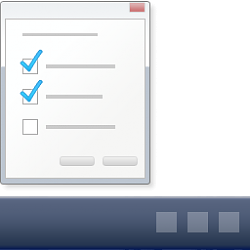How to Enable or Disable Resizing the Taskbar in Windows
Windows includes a special application desktop toolbar called the taskbar that shows on the bottom of a display screen by default. The taskbar allows you to find, see, open, and switch between your apps. You can also see the date and time, system icons, and items running in the background on the notification area. You can make the taskbar look how you want, manage your calendar, pin your favorite apps to it, change the size, change location on screen, and specify how taskbar buttons group together when you have more than one window open.
If you have the taskbar location at the top or bottom border of your display, you can change the height of the taskbar to what you want.
If you have the taskbar location at the left or right border of your display, you can change the width of the taskbar to what you want.
This tutorial will show you how to enable or disable the ability to resize the taskbar for specific or all users in Windows 7, Windows 8, and Windows 10.
You must be signed in as an administrator to enable or disable resizing the taskbar.
- Option One: Enable or Disable Resizing the Taskbar in Local Group Policy Editor
- Option Two: Enable or Disable Resizing the Taskbar for All Users using a REG file
EXAMPLE: Resizing the taskbar
In Windows 7, the Local Group Policy Editor is only available in the Professional, Ultimate, and Enterprise editions.
In Windows 8, the Local Group Policy Editor is only available in the Pro and Enterprise editions.
In Windows 10, the Local Group Policy Editor is only available in the Pro, Enterprise, and Education editions.
All editions can use Option Two.
1. Open the all users, specific users or groups, or all users except administrators Local Group Policy Editor for how you want this policy applied.
2. In the left pane of the Local Group Policy Editor, click/tap on to expand User Configuration, Administrative Templates, and Start Menu and Taskbar. (See screenshot below)
3. In the right pane of Start Menu and Taskbar, double click/tap on the Prevent users from resizing the taskbar policy to edit it. (see screenshot above)
4. Do step 5 (enable) or step 6 (disable) below for what you would like to do.
A) Select (dot) either Not Configured or Disabled, click/tap on OK, and go to step 7 below. (see screenshot below)
Not Configured is the default setting.
7. When finished, you can close Local Group Policy Editor if you like.
8. Restart the explorer process, sign out and sign in, or restart the computer to apply.
The downloadable .reg files below will add and modify the DWORD value in the registry keys below.
HKEY_CURRENT_USER\Software\Microsoft\Windows\CurrentVersion\Policies\Explorer
HKEY_LOCAL_MACHINE\SOFTWARE\Microsoft\Windows\CurrentVersion\Policies\Explorer
TaskbarNoResize DWORD
(delete) = Enable
1 = Disable
1. Do step 2 (enable) or step 3 (disable) below for what you would like to do.
This is the default setting.
A) Click/tap on the Download button below to download the file below, and go to step 4 below.
Enable_resizing_taskbar.reg
Download
A) Click/tap on the Download button below to download the file below, and go to step 4 below.
Disable_resizing_taskbar.reg
Download
4. Save the .reg file to your desktop.
5. Double click/tap on the downloaded .reg file to merge it.
6. When prompted, click/tap on Run, Yes (UAC), Yes, and OK to approve the merge.
7. Restart the explorer process, sign out and sign in, or restart the computer to apply.
8. You could now delete the downloaded .reg file if you like.
That's it,
Shawn
Related Tutorials
- How to Change Height or Width Size of Taskbar in Windows 10
- How to Enable or Disable Lock the Taskbar in Windows 10
- How to Enable or Disable Moving Taskbar Location on Screen in Windows 10
- How to Enable or Disable Taskbar Settings in Windows 10
Enable or Disable Resizing the Taskbar in Windows

Enable or Disable Resizing the Taskbar in Windows
How to Enable or Disable Resizing the Taskbar in WindowsPublished by Shawn BrinkCategory: General Tips
28 Feb 2018
Tutorial Categories


Related Discussions





